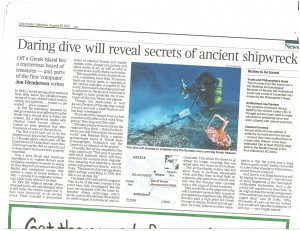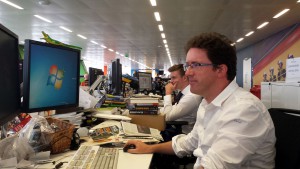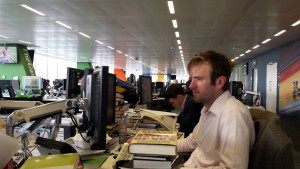
December 22, 2015, by Jon Henderson
Working as a science journalist at The Times
As the end of year deadline of the Christmas period approaches, teaching is finished and I am trying to catch up with imminent grant proposals, a commissioned book chapter and yet more teaching prep. Thinking purely in terms of putting these tasks off as long as possible, I’ve just realised that I haven’t yet written about my experience working as a science journalist last September.
As part of a British Science Association Media Fellowship I spent 3 weeks working in the offices of The Times and then one week covering the Bradford Science Festival for them. The idea of the fellowship is that, through working at the heart of a major media organisation, academics gain first hand insight into the ways science research becomes news. This is of course of central importance to universities these days as they strive to demonstrate that their research has an impact beyond the hallowed halls of academe.
A typical day at The Times began around 8am when the Times science journalists start to trade emails about the potential stories of the day that might be taken to the main pitching conference at 10.30am. Most journalists then arrive at the office around 10am and a final list to be taken to the conference is decided. If you have any exclusive stories you may want to do, you have to pitch them to the news editors before they head into the main conference. The news editors then head to a meeting to discuss the layout of the paper for the next day. Around 11.30am the stories that the paper editors are interested in covering are circulated to the science desk and you are given one or two stories by the Science Editor to write up that day.
One of the most interesting aspects of the job is that these stories can be on anything. I wrote stories on aspirin, breast feeding, nanotechnology, mind controlling parasites, fossil flowers, smoking rates, toddlers cognitive function, sending messages to contact alien life, shipwrecks, Stonehenge and how the choice of toys given to children ultimately affects gender balance figures in science.
Then it is entirely over to you and the real work begins. Working from the press releases and, if available, the journal paper, you begin to put your angle on the story together. You also try to contact the project leaders of the science work you are covering for an interview and, if necessary, contact people in the same field to comment on the work. This is an opportunity to talk directly to scientists at the cutting edge of their fields and ask them about their research. Ideally you get to talk to the people you need and your stories begin to take shape. You might have to liaise with the pictures editor to decide on some images to accompany your story.
Deadlines loom from 4pm to, at the latest, 6pm when you have to submit your story within the word limits asked for (generally from 400 to 700 words). Once submitted you breathe a sigh of relief and catch the tube home. However, you need to stay within contact by phone in case the copy editors have a question or need some further clarification about your story before it is published. At the copy editing stage your story can be cut down and you will not see the results until it appears in the paper the next day.

I pitched an exclusive story on the Kythera project in Greece which was used as an 800 word page lead in the Times Saturday edition (29th Aug).
The next morning prior to the email exchanges from 8am you check the online edition of the paper to see if your story made the cut. There are no guarantees and you only know the next day if all the work you have put in was worthwhile. The news is constantly changing and you may have written a perfectly good story which the editor were happy with but was then cut from the final paper because new content came in and pushed it out.
A good example early on was when one of the editors called me over to tell me my article on the cancer fighting properties of wasp venom was going to be the lead story on page 9. As he was talking the mock-up of the page for tomorrows newspaper on his computer flashed and my story was replaced with a large photo of Boris Johnson getting his hair cut. I learned that you cannot afford to be precious about news stories – The Times can be particularly harsh in this regard because for the most part if a story does not make the print version of the paper then it is not uploaded on the online version.
Unlike academia where you deal with a particular topic in detail for months or years, in science reporting you have the thrill of dipping into a different scientific discipline or discovery every day. At the beginning of each day you do not know what you will be covering from aspirin trials and aliens to nanotechnology and shipwrecks. Then you spend the day trying to get up to speed to cover that particular story. For one day you immerse yourself in that research, get to speak to world leaders conducting the research, write it up and then move on.
I came away from the experience with strong respect for the science journalists at The Times (they really cared about the science aspect of the stories they covered not the sensationalist ones – if the science was bad then they wouldn’t cover it) and a realisation that stories need to be properly managed and embargoed to make national news (something we are not generally very good at in the Humanities). Newspapers take science news mainly from EurekAlert! – an online news service. Not only do we need to ensure our stories are on the networks journalists use but, just as importantly, we need to then be prepared to deal with multiple requests for interviews and further information that follow. You would be surprised how many academics were unreachable for comment on the day before their supposedly timed press embargoed stories broke, effectively killing off any coverage of the story.
The problem of timing is particularly acute for archaeology as most archaeologists see talking to the public and, in turn, the press as a core part of their activity – after all if we are not informing people about the past then what are we doing? As a result rather than embargoing information archaeologists tend to talk to anyone and everyone at all stages of a project. This often means that projects are covered in the press in their initial phases when excavations have just started or are still taking place. However, the best results come much later after the excavated data has been fully analysed and the final reports written. Because archaeologists have already spoken at random to member of the press prior to this it can often then be difficult to get the final and most important outcomes of finished projects into the news.
Speaking personally probably the biggest culture shock for me was having a strict deadline every day. I am used to more, shall we say, malleable writing deadlines. “Can’t get your chapter in this week? No problem we are still waiting for a few others. You know how busy academics are!”
Probably that and working in an open plan office. Trying to write while people around me talk about news, pitch stories, answer the phone, breathe, generally exist and, worst of all, type in an absurdly proficient fashion. Every expertly executed keyboard click gnawing into my head and reminding me that while the person across from me is happily writing up their article, I am not. I’m listening to them typing. My deadline is looming and I’m listening to them typing. Aaaaarrrggghhh! Get a grip. It’s 4 o’clock, my story needs to be submitted in an hour…. Happy days!
Short interview on the placement on Youtube: https://www.youtube.com/watch?v=xU5QP5-TnNM
If you have a Times account you can read some of the stories I covered here.
No comments yet, fill out a comment to be the first




Leave a Reply